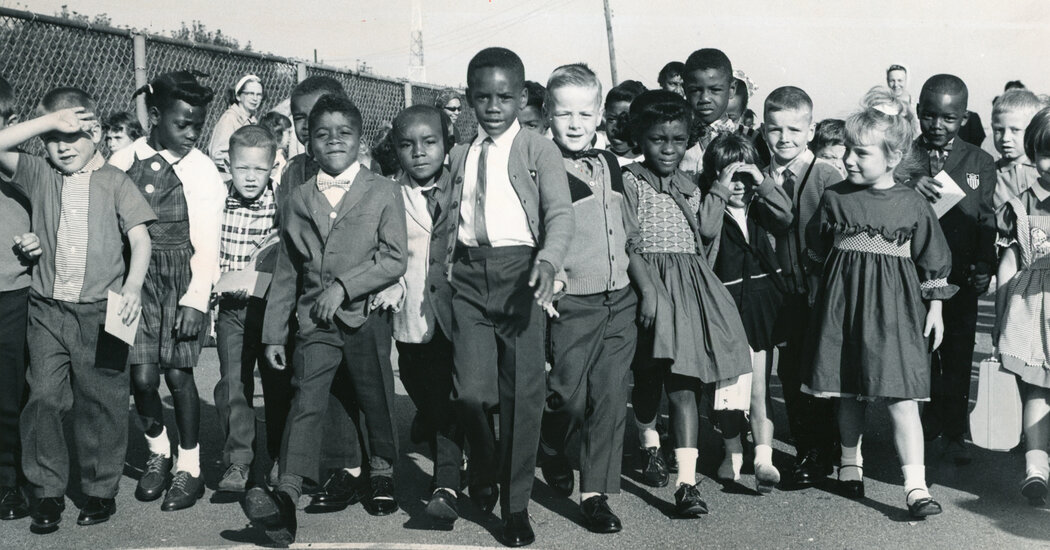
You most likely know that the landmark 1954 Supreme Court decision Brown v. Board of Education ruled that racial segregation in U.S. public schools was unconstitutional. You may also know that the decision ordered states to desegregate “with all deliberate speed.”
Less talked about is the 1969 decision in Alexander v. Holmes County Board of Education, which, after years of obstruction by many states through the 1950s and 60s, ordered that racially segregated schools must immediately desegregate. In other words: You know what we said back in 1954? We actually meant it.
Some of the ramifications and subsequent events are captured in two complementary documentaries from the PBS “American Experience” series. “The Busing Battleground,” directed by Sharon Grimberg and Cyndee Readdean, explores the long buildup to and catastrophic results of busing in Boston, by which students were bused to schools outside their neighborhoods in an effort to desegregate the public school system. Busing saw the city explode in violence and exposed the ferocity with which residents were willing to defends ethnic neighborhood borders. It premieres on Sept. 11.
“The Harvest,” produced by the Pulitzer Prize-winning journalist Douglas A. Blackmon and the Oscar-nominated filmmaker Sam Pollard, takes Blackmon back to the small Mississippi town where he grew up, where he was part of the first local class of integrated students to matriculate from first grade to high school. It premieres on Sept. 12.
The films arrive at a time when many of the hard-fought gains of desegregation have been reversed and when some schools, according to a report released in May by the U.S. Department of Education, are more segregated than they were before courts intervened. Both underscore what has changed — and what hasn’t — in the almost 70 years since Brown while also questioning tidy presumptions.
“These two stories are in conversation with each other,” said Cameo George, the executive producer of “American Experience.” “In some ways they’re almost counterintuitive, because we are all accustomed to thinking that integration in the South was violent, and in the North communities were much more open and progressive. By putting the films together, it just challenges your assumptions in a really interesting way.”
Both films also grapple with an unavoidable question: Why has the process been so difficult?
Today, when segregation is rife in even some of the country’s most ostensibly liberal enclaves, the reasons aren’t always plain or openly acknowledged. In the decades following Brown, they were often pretty overt. A lot of white parents, in the supposedly enlightened North as well as the historically segregated South, were willing to go to great lengths to keep their children away from their Black peers. And a lot of politicians were happy to help them make it so.
When many people think about segregated facilities — schools, water fountains, restrooms — they think about the Jim Crow South. But “The Busing Battleground” shows just how determined many white citizens were to keep Boston schools segregated, particularly in the largely Irish enclaves of South Boston and Charlestown.
These were self-enclosed neighborhoods that didn’t cotton to change, or to Black people. “The Busing Battleground” shows how Black Bostonians, led by the tireless Ruth Batson, tried to integrate the city’s schools by way of the ballot box, direct action and the courts. The white people in power, led by Louise Day Hicks, then the head of the Boston School Committee, stonewalled and riled up public support for the status quo.
“All the liberal, white, ‘Oh, that stuff happens in the South, we’re so progressive’ stuff just got thrown right out the window,” Readdean said in a video this month. “Nobody was progressive anymore.”
Grimberg, on the same video call, added: “Our hope is that people see this as an important Northern civil rights story. We’ve heard lots of Southern stories, but this is a story of a very long, protracted struggle for educational rights for Black kids in the North.”
By 1974, when the Federal judge W. Arthur Garrity Jr. mandated the integration of Boston schools by busing, the tension had long been building. Images captured from the first days of busing, when Black students from Roxbury came to South Boston High School, remain disorienting in their violence. Many teens and their parents hurled bricks, bottles and rocks at the buses — and hurled the N-word with abandon. As you watch, you have to keep reminding yourself that this is a Northern city in the 1970s.
One of the most potent and memorable images of the period, a Pulitzer-winning photo by Stanley Forman, shot during a Bicentennial protest by white high schoolers against busing, shows a Black attorney and civil rights activist, Ted Landsmark, being held by a couple of white protesters while another moves to assault him with an American flag. Landsmark is interviewed in the film, describing how he feared for his life on that day.
“The Harvest,” too, features an image from Bicentennial commemorations, this one from Blackmon’s small hometown, Leland, Miss. The home movie shows a festive and peaceful parade through downtown, with Black and white Cub Scouts stepping in unison while a band, which includes a young Blackmon, marches along.
The integration of Leland public schools wasn’t always so idyllic, as the film makes clear. But compared to what was happening in Boston, which one observer describes as “up South,” the Leland process was indeed a stroll down the street.
Blackmon, who is white, was part of Leland’s class of 1982, the first integrated group of students to matriculate through the town’s public schools. (He did his senior year in another town after his father got a new job.) He recalled an upbringing defined by interracial friendships at school that generally didn’t carry over after the final bell rang — when, for instance, he wanted to play G.I. Joe dolls with his Black friends, and parents on both sides of the racial divide discouraged it.
What he didn’t realize then was that the new private schools popping up after the 1969 Supreme Court decision were organized largely by White Citizens’ Councils — essentially white-collar versions of the Ku Klux Klan — with secret covenants to exclude Black teachers and students. Beneath the placid surface, Leland’s schools were resegregating.
“There really was this overt plan to create a whole new system of schools, and to try to extract, if possible, all white kids from the public schools and then to actively undermine those schools,” Blackmon said from a rented lake house in South Carolina. “But Leland was different in that it avoided some of that incredibly rough stuff that did happen in some other places in the South, and that we certainly saw in Boston.”
Blackmon and his co-producer, Pollard, who is Black, worked together previously on the 2012 documentary adaptation of Blackmon’s 2008 book “Slavery by Another Name,” an account of the Jim Crow-era convict leasing system, for which he won a Pulitzer. It made sense to have a racially integrated creative team for such a contentious story. The makers of “The Busing Battleground” also found this to be the case.
“It was valuable to have the two of us on this project,” Readdean, who is Black, said. “Sometimes, especially because the subject’s so raw for the people that lived through it, some of the whites maybe were more forthcoming talking to Sharon than they would have been with me. We wanted interviews with truthful recollection, not something where they’re trying to be all P.C.
“I felt the same way when we were talking with the Black participants, that they could just reveal what they wanted to reveal talking to me.”
Both films come to the same unfortunate if inevitable conclusion: The schools of Boston and Leland have largely resegregated since the ’70s, with many white families fleeing to private or parochial schools, or to the suburbs. But Blackmon found some silver linings in the lives of his Black former classmates, some of whom left and came back to fill key municipal positions.
One, Jessie King, is now the school district’s superintendent, at a time when Mississippi’s public schools are on the upswing. Another, Billy Barber, is police chief.
They are the better part of the harvest that gives the film its title, residents who seized new opportunities and then gave back to the community where they were raised. They’re a reminder that not all of the purpose and intent that accompanied the integration of Leland schools have faded.
“At a very fundamental level, the lesson and the takeaway is that you reap what you sow,” said George, the executive producer. “If you want a better educated population, and you want kids to graduate with not just academic skills, but personal skills, so that they can become productive members of the work force and productive members of society, you have to invest in that. It doesn’t just happen.”













